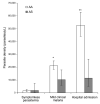Sickle cell trait and the risk of Plasmodium falciparum malaria and other childhood diseases
- PMID: 15942909
- PMCID: PMC3545189
- DOI: 10.1086/430744
Sickle cell trait and the risk of Plasmodium falciparum malaria and other childhood diseases
Abstract
Background: The gene for sickle hemoglobin (HbS) is a prime example of natural selection. It is generally believed that its current prevalence in many tropical populations reflects selection for the carrier form (sickle cell trait [HbAS]) through a survival advantage against death from malaria. Nevertheless, >50 years after this hypothesis was first proposed, the epidemiological description of the relationships between HbAS, malaria, and other common causes of child mortality remains incomplete.
Methods: We studied the incidence of falciparum malaria and other childhood diseases in 2 cohorts of children living on the coast of Kenya.
Results: The protective effect of HbAS was remarkably specific for falciparum malaria, having no significant impact on any other disease. HbAS had no effect on the prevalence of symptomless parasitemia but was 50% protective against mild clinical malaria, 75% protective against admission to the hospital for malaria, and almost 90% protective against severe or complicated malaria. The effect of HbAS on episodes of clinical malaria was mirrored in its effect on parasite densities during such episodes.
Conclusions: The present data are useful in that they confirm the mechanisms by which HbAS confers protection against malaria and shed light on the relationships between HbAS, malaria, and other childhood diseases.
Figures

References
-
- Murray CJ, Lopez AD. Global mortality, disability, and the contribution of risk factors: Global Burden of Disease Study. Lancet. 1997;349:1436–42. - PubMed
-
- Snow RW, Craig MH, Newton CRJC, Steketee RW. The public health burden of P. falciparum malaria in Africa: deriving the numbers. Fogerty International Center, National Institutes of Health; Bethesda, MD: 2003.
-
- Allison AC. Polymorphism and natural selection in human populations. Cold Spring Harb Symp Quant Biol. 1964;29:137–49. - PubMed
-
- Gilles HM, Fletcher KA, Hendrickse RG, Lindner R, Reddy S, Allan N. Glucose-6-phosphate-dehydrogenase deficiency, sickling, and malaria in African children in South Western Nigeria. Lancet. 1967;1:138–40. - PubMed
-
- Willcox M, Bjorkman A, Brohult J, Pehrson PO, Rombo L, Bengtsson E. A case-control study in northern Liberia of Plasmodium falciparum malaria in haemoglobin S and beta-thalassaemia traits. Ann Trop Med Parasitol. 1983;77:239–46. - PubMed

